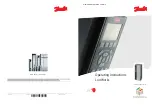
8
If the Digital display, displays a fault code follow the steps outlined in the “Troubleshooting” section of this Instruction
Manual. The Fault LED will light if there is an excessive voltage drop between the (battery) power source and the
inverter.
Note:
Reverse polarity or short circuit condition may cause external or internal fuses to open and may cause irreversible
damage to the Power Inverter. Take extra care to ensure a proper polarity hook-up.
CAUTION
• If turning the ON/OFF Switch off, then on again does not reset the inverter, DO NOT ATTEMPT TO OPEN THE
INVERTER. Opening the inverter for any reason will void the warranty. The unit must be returned to manufacturer
for testing and repair by professional factory technicians.
INSTALLATION
Your inverter will provide you with continuous electrical power when powered by a reliable 12 volt DC source, such
as a vehicle battery or a multiple battery configuration. This manual does not describe all of the possible
configurations.
Operating Environment
For best operating results, your inverter should be placed on a flat surface, such as the ground, car floor or seat or
other solid surface to help diffuse the heat that is generated. Position the inverter as close to the DC power source
as possible.
The inverter should only be operated in locations that meet the following criteria:
DRY – Do not allow water and/or other liquids to come into contact with the inverter.
COOL – Ambient air temperature should be between 30°F (–1°C) non-condensing and 105°F (40°C). Do not place
the inverter on or near a heating vent or any piece of equipment that is generating heat above room temperature.
Keep the inverter out of direct sunlight.
VENTILATED – Allow at least three inches of clearance from other objects to ensure free air circulation around the
inverter. Never place items on or over the inverter during operation.
SAFE – Do not locate inverters in an area, room or compartment where explosives or flammable fumes might be
present, such as engine rooms, engine compartments and boats or small, unvented battery compartments.
Marine Applications
In all marine applications, DO NOT install the inverter below or near the waterline; and keep the inverter away from
moisture and water.
Use ONLY non-corrosive marine fasteners and fittings for installation. Only connect the inverter’s DC input to
existing wiring (that has been approved for marine use) at the appropriate gauge, cable and length. The cable, fuse
holder and fuse (not supplied) can be purchased at an electrical supply company. Call the manufacturer for
additional installation information.
Quick Operational Test or Emergency Use
You will need:
• A heavy-duty jumper cable set of the specified AWG wire rating (refer to the “Specifications” section of this
Instruction Manual)
• A fully-charged automobile battery
• A common slip joint plier for loosening and tightening terminal nuts
PROCEDURE
1. Unscrew nuts in input terminal block.
2. Identify the positive and negative terminals on the 12 volt DC battery (or other 12 volt DC power source) and
identify the positive and negative terminals on the inverter.
3. Using a set of heavy-duty jumper cables, attach the red cable to the inverter’s positive (+) terminal and the black
cable to the inverter’s negative (–) terminal.
4. Connect the clamps on the other ends of the jumper cables to the corresponding positive (+) and negative (–)
terminals on the 12 volt DC vehicle battery (or other 12 volt DC power source). There may be some minor
sparking.
5. Turn the inverter ON/OFF Switch on.
6. Plug in a lamp with a 100 watt light bulb and switch the lamp on. If the lamp works normally, the inverter is
functioning properly and you can proceed to a permanent installation or continue to use the inverter with low
wattage appliances. If the lamp does not light or does not work correctly:




































